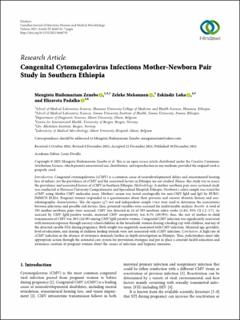| dc.contributor.author | Zenebe, Mengistu Hailemariam | |
| dc.contributor.author | Mekonnen, Zeleke | |
| dc.contributor.author | Loha, Eskindir | |
| dc.contributor.author | Padalko, Elizaveta | |
| dc.date.accessioned | 2022-02-01T09:27:44Z | |
| dc.date.available | 2022-02-01T09:27:44Z | |
| dc.date.created | 2022-01-28T18:30:37Z | |
| dc.date.issued | 2021 | |
| dc.identifier.issn | 1712-9532 | |
| dc.identifier.uri | https://hdl.handle.net/11250/2976184 | |
| dc.description.abstract | Introduction. Congenital cytomegalovirus (cCMV) is a common cause of neurodevelopmental delays and sensorineural hearing loss of infants, yet the prevalence of cCMV and the associated factors in Ethiopia are not studied. Hence, this study was to assess the prevalence and associated factors of cCMV in Southern Ethiopia. Methodology. A mother-newborn pair cross-sectional study was conducted at Hawassa University Comprehensive and Specialized Hospital, Ethiopia. Newborn’s saliva sample was tested for cCMV using Alethia CMV molecular assay. Mothers’ serum was tested serologically for anti-CMV IgM and IgG by EUROIMMUN ELISA. Pregnant women responded to a questionnaire about their previous and current obstetric history and sociodemographic characteristics. The chi-square (χ2) test and independent-sample t-test were used to determine the associations between infections and possible risk factors; then, potential variables were screened for multivariable analysis. Results. A total of 593 mother-newborn pairs were assessed. CMV was detected in 14 of 593 newborn saliva swabs (2.4%; 95% CI 1.2–3.7). As assessed by CMV IgM-positive results, maternal CMV seropositivity was 8.3% (49/593); thus, the rate of mother-to-child transmission of CMV was 28% (14/49) among CMV IgM-positive women. Congenital CMV infection was significantly associated with maternal exposure through nursery school children in the household, women sharing a feeding cup with children, and any of the detected curable STIs during pregnancy. Birth weight was negatively associated with CMV infection. Maternal age, gravidity, level of education, and sharing of children feeding utensils were not associated with cCMV infection. Conclusion. A high rate of cCMV infection in the absence of awareness demands further in-depth investigation in Ethiopia. Thus, policymakers must take appropriate action through the antenatal care system for prevention strategies and put in place a constant health education and awareness creation of pregnant women about the causes of infection and hygienic measures. | en_US |
| dc.language.iso | eng | en_US |
| dc.publisher | Hindawi | en_US |
| dc.rights | Navngivelse 4.0 Internasjonal | * |
| dc.rights.uri | http://creativecommons.org/licenses/by/4.0/deed.no | * |
| dc.title | Congenital Cytomegalovirus Infections Mother-Newborn Pair Study in Southern Ethiopia | en_US |
| dc.type | Journal article | en_US |
| dc.type | Peer reviewed | en_US |
| dc.description.version | publishedVersion | en_US |
| dc.rights.holder | Copyright © 2021 Mengistu Hailemariam Zenebe et al. | en_US |
| dc.source.articlenumber | 4646743 | en_US |
| cristin.ispublished | true | |
| cristin.fulltext | original | |
| cristin.qualitycode | 1 | |
| dc.identifier.doi | 10.1155/2021/4646743 | |
| dc.identifier.cristin | 1992896 | |
| dc.source.journal | Canadian Journal of Infectious Diseases and Medical Microbiology | en_US |
| dc.identifier.citation | Canadian Journal of Infectious Diseases and Medical Microbiology. 2021, 2021, 4646743. | en_US |
| dc.source.volume | 2021 | en_US |

